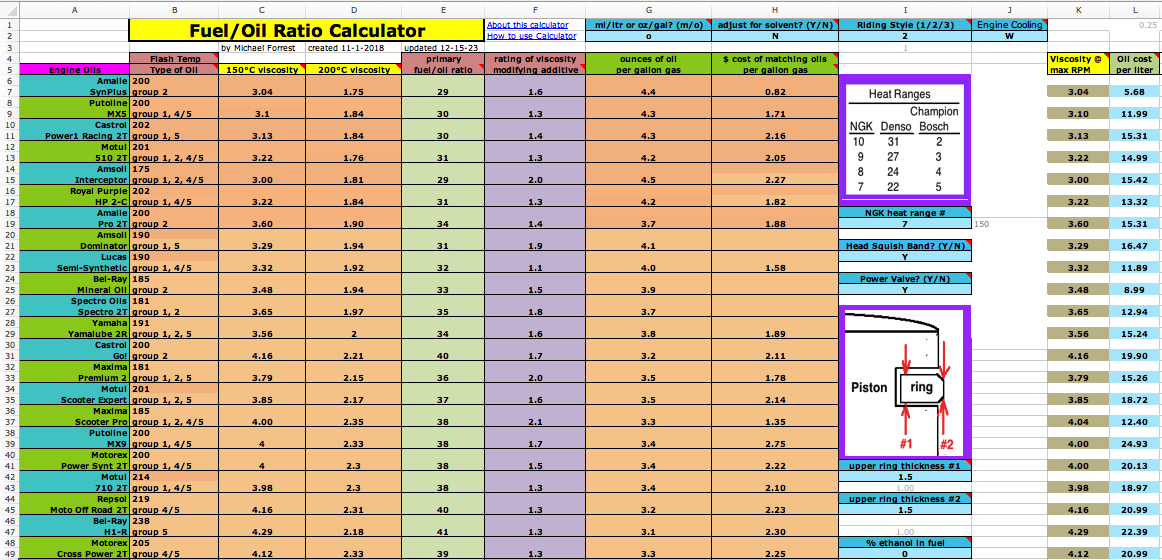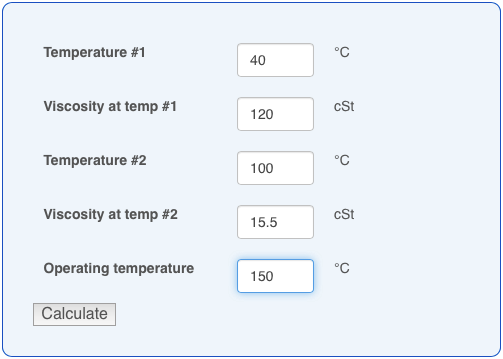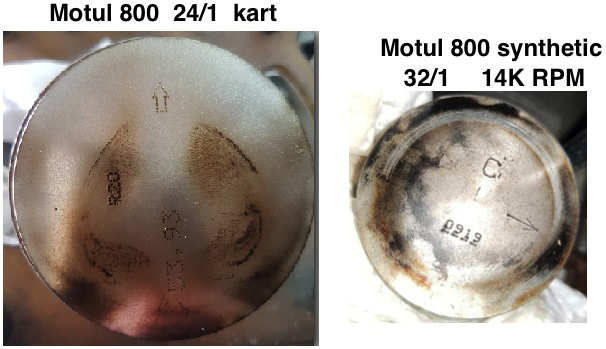|
This calculates the fuel/oil ratio you need according to engine heat (by the NGK heat range #) and oil viscosity (the main measure of oil effectiveness) at the estimated upper cylinder temperature. It recommends a handful of oils and gives a price comparison among them. So far there are 41 different engine oils already programed into the calculator and space to enter more.  There are two ways to think about fuel/oil ratios - for protection, and for power. This calculator tells a good ratio for protection. If you want more power then use an oil with castor. If you use more than what is needed of a high viscosity synthetic oil for decent racing protection then at low and mid range RPM you have more power loss due to viscous friction, more spooge, and less life of your spark plug till it fouls. A sign of using too much synthetic oil is lack of carbon pattern on the piston top. The method that my calculator uses is that for oils other than the 41 oils already plugged into it the user goes to this site and types in the engine oils 40C and 100C viscosities to find out the viscosities at 150C and 200C and then enters those into the spreadsheet in columns C and D at the bottom of my spreadsheet.  Then the calculator determines the max upper cylinder temperature and the consequent viscosity of the engine oil at that temp (since the viscosity lessens with more heat). Then it determines the fuel/oil ratio needed to have a certain mixed viscosity (diluted by gasoline) on the upper cylinder for ring protection. The idea is that ring protection at the elevated temps there requires the most viscosity of all the engine parts. This method is not far off from what some manufacturers are recommending for the needed fuel/oil ratios. It's a bit "off" only because it's more specific than what they recommend. So in reality the manufacturer recommendations are a bit off because they are too generic. My calculator gives a baseline ratio that can be changed for slightly more oil but shouldn't be changed for less oil to be mixed with gas, especially for ashless and FD rated oils used in competition engines because these oils have little to no ash producing additive which is there as a dry lubricant backup when engine stress is extreme. Click here for info on all my other 2 stroke design spreadsheet calculators. Why should anyone use this info to double-check that they are using enough oil? Well, people really can't rely on other riders recommendations because they range from really well informed to completely nuts. They should use this info and calculator to make sure they are getting enough viscosity at the rings unless they like doing engine rebuilds with all the included cost of rings and gaskets. This calculator is an attempt to remove some of the guesswork by providing this info so you can double check that the fuel/oil ratio you use provides enough final mixed gas/oil viscosity for adequate protection. That is minimal. Using even more oil than that would be even better as long as it doesn't create spooge or foul plugs. I don't doubt that I have inadvertently cut short the life of various engines of mine due to my ignorance of engine oils, but not any more. This administrator of an online forum did a thorough test of the AMSoil Saber Professional Oil and found that the more oil that was added to the gas, the less ring wear there was for the same mileage. My calculator says it should be used at 48:1 fuel/oil ratio. Here is his results: Listed here are the before and after ring end gaps using different engine fuel/oil ratios on a 1E40QMB Air Cooled Chinese Minarelli Clone reving to 9000 RPM for 100 miles. AMSOil Saber synthetic oil ratio ring end gaps before and after 40:1 - .012", .015" (.003" wear) 50:1 - .019", .023" (.004" wear) 80:1 - .031", .037" (.006" wear) This is just one example of how useful this calculator is. The bottle recommends 80:1 for weedeaters but for motorcycles my calculator says 48:1. Here's some customer feedback on the treatland.tv website (scooter parts) where this person is warning against using AMSoil at the recommended low oil ratio.  I had read another warning on another site saying that using it at 80:1 caused piston seizures in 3 of his bikes. Unfortunately I didn't copy the site URL and couldn't find it again later. Originally this oil at this ratio was recommended only for lawn care engines but then they got greedy and started advertising it for motorcycles/scooters also without changing the recommended ratio for the higher stress engines. This is only one of many possible examples of the lack of integrity in the engine oil industry. Stupidity usually pairs up with dishonesty and this has been the norm for a long time which is why there has never been any software offered by the oil manufacturers like what I now offer. Too much oil causes spooge (unburned oil) and too little oil causes premature wear of the rings. Examples of my calculators trueness: for fully synthetic oils: Motul recommends their 800 Off Road be used at 50:1 and my calculator shows its ratio to be the same for a water cooled engine reving to 12,000 RPM. I choose 12,000 for extreme use because that is what a modern 125cc revs to. And the oil manufacturers usually recommend a racing oil at a ratio that will protect an extreme motocross engine such as a 125cc. Bel-Ray's rep emailed me that he recommends their H1-R be used at 40:1 for 125cc motocross and my calculator shows 35:1 for it. for a mineral oil: Spectro 2T is not advertised as a racing oil but something that can be used in oil injector systems so we can say it is for up to 10,000 RPM at the recommended ratio of 32:1 and my calculator shows 35:1 for it. - - - - emailed to me from Bel-Ray: "Lubrication quality is going to be very similar between synthetic and non-synthetic base oils. Synthetic oils typically burn more cleanly than comparable mineral oils so they tend not form as many deposits and produce as much residue; which can effect the lubrication process. Some synthetics do form very strong films though, such as esters. Those esters form polar bonds to the metal which gives them some extra ability to resist the breaking down of the lubricant film. This property is independent of viscosity." - - - - According to mototribology, a true synthetic oil has a higher viscosity index than a highly refined petroleum oil that is passing as a synthetic. Other than looking for a high viscosity index as an indication of how truly synthetic it is, a high product price is an indication that true synthetic oil is used because it costs 1.5 to 4 times as much. When a choice of two or more oils are available, always choose the one with the highest viscosity index if you want the best oil. - - - - The main differences in JASO FC and FD is that FD has more detergency (low deposits) and the sulfated ash mass percent was decreased from .25% in FC to .18% in FD. They are the same in these areas: lubricity, exhaust smoke, flash point (over 70ºC), and over 6.5 cSt viscosity @ 100ºC. The ISO L-EGD and JASO FD are the exact same performance specification. API TC = JASO FC (under .25% ash) API TC products will tend to give better in-service performance in small portable power equipment, while JASO FC products will tend to exhibit better in-service performance in larger, air-cooled motorcycle engines. Many 2-cycle air-cooled engine oils are marked with ISO GD, GC, GB; JASO FA, FB or FC; and/or with the API TC designation. FD designates little to no ash (under .18%). - - - - Ash is the non-combustible residue of a lubrication oil or fuel. Detergent additives contain metallic derivatives, such as calcium, barium and magnesium sulfonates that are common sources of ash. Ash deposits can impair engine efficiency and power. But, detergents are an important component of engine oil that help control varnish deposits, piston ring deposits, and rust by keeping insoluble combustion particles from adhering to metal surfaces. In some cases, detergents neutralize acids formed from combustion of the fuel mixture. Ash deposits may have a grayish color, where carbon residue is usually black and sooty. Carbon residue is formed from partially burned oil. - - - - Final Considerations The main advantage of a synthetic oil is not its high fuel/oil ratio* but its ability to maintain a decent viscosity at extreme engine temps, its lack of exhaust smoke, and lack of carbon deposits. The main advantage of a mineral oil is that due to its lower viscosity you need to add more of it to your gas for best ring sealing (for more power) and lowering of piston temps, and best engine power since it burns good and adds to the combustion force [read more]. * some people think that more oil means less power because it displaces gasoline. This is true only with synthetics. Engine tests using mineral oil shows a 18:1 ratio gives the best power. Both synthetic and mineral oils burn but the highly refined mineral oils burn the best, regular mineral oils burn second best, and synthetics burn the least. So although you might still have decent engine protection at a high fuel/oil ratio of a synthetic, you still are without the best possible engine power compared to a mineral oil. I blended Motul 800 Road Racing oil 50/50 with Bel-Ray Mineral Oil at a 25:1 fuel/oil ratio and noticed a nice boost in power. But the carbon deposits were significant after only 200km. So I'm convinced that more oil is better for good power. But no one likes to have to take the engine apart often to clean off the carbon. This screenshot fails to show 23 more oils that are programmed into the calculator. After you enter the needed data then the program displays all the ratios needed for each oil in column E, and in column F the ounces or ml needed per gallon or liter of gasoline. In column G it shows comparative costs only for the oils which have enough flash point temp for the estimated upper cylinder temp to keep from evaporating off.  Click here if you want to buy this calculator. "I used your oil ratio calculator for my latest track day (85% for safety). It didn't smoke as much, and I never oil fouled a plug. I'm using Motul 800 Race and was at 32:1 ratio and went with 45:1 from your calculator. Worked great, thank you." Excess Synthetic Oil and Less Power If you add so much synthetic oil that the piston top shows vague wash patterns like in the photos below then 1) your piston isn't being allowed to get hot enough to vaporize gasoline. Some vaporization makes the mix more homogenous for more consistent combustion events. 2) you are missing out on power due to the slow combustion of synthetic oil. Using less oil or switching to a semi-synthetic oil will yield more power. CLICK HERE to read more.  If you want a recommended Fuel/Oil Ratio from my calculator just Paypal me $10 (to a57ngel@yahoo.com) with your details (max RPM, type cooling, whether or not it has a power valve, what your desired fuel/oil ratio is if you have one in mind) and I will send you a list of recommended oils, their needed ratios for your engine, and their cost per gallon of gas. |